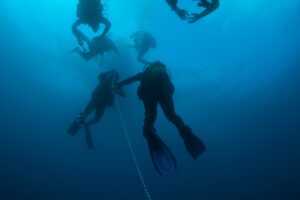What is a Jon Line?
A jon line is a specialized piece of equipment used by scuba divers to maintain a stable position underwater, particularly during decompression stops in strong currents. It is essentially a length of cord or webbing, typically around 1.5 to 2 meters (4.9 to 6.6 feet) long, equipped with a clip or carabiner at one end and sometimes a handle or loop at the other. The term “jon line” is derived from its creator, Jon Hulburt, a diver who saw the need for such a tool to aid divers in holding their position without expending excessive energy. In technical and recreational diving, the jon line has become a crucial tool for ensuring safety and reducing physical exertion during prolonged stops.
Definition and Description
A jon line is designed to help divers in maintaining their position in the water column during decompression stops, safety stops, or while waiting for an ascent line in strong current conditions. The primary component of a jon line is the cord or webbing, which is chosen for its durability and resistance to wear and tear from saltwater exposure. Materials such as nylon or polypropylene are commonly used due to their strength and lightweight properties.
The length of a jon line is carefully considered to balance between providing sufficient reach and minimizing tangling risks. Typically, a jon line measures between 1.5 to 2 meters (4.9 to 6.6 feet) in length. One end of the jon line features a clip or carabiner, which allows the diver to attach it to a fixed object, such as an ascent line, anchor line, or even a rock formation. The opposite end may have a handle or loop, which the diver holds onto or attaches to their buoyancy control device (BCD).
Variations in design exist to cater to different diving environments and preferences. Some jon lines incorporate reflective strips for better visibility, while others may have additional features like adjustable lengths or breakaway connections for safety. The versatility and simplicity of the jon line make it a favored tool among both novice and experienced divers.
Historical Development
The jon line was conceived out of necessity by Jon Hulburt, who identified a gap in the existing diving gear for maintaining stability during decompression stops. In the early days of scuba diving, divers relied on holding onto the ascent line or swimming against the current to maintain their position. These methods were physically demanding and could lead to increased air consumption and fatigue.
Hulburt’s innovation of the jon line provided a practical solution by allowing divers to clip onto a stable line and relax while maintaining their depth. This invention quickly gained popularity, particularly among technical divers who frequently performed long decompression stops. Over time, the design of the jon line evolved, with improvements in materials and construction to enhance durability and usability.
Significant milestones in the development of the jon line include the adoption of more robust and lightweight materials, such as high-strength polymers and stainless steel clips. These advancements have made jon lines more reliable and easier to handle underwater. The evolution of diving practices and the emphasis on safety have cemented the jon line’s place as an essential piece of diving equipment.
Technical Aspects
Using a jon line involves a straightforward process, but understanding the technical aspects is crucial for effective and safe operation. The primary function of a jon line is to provide a tether point for the diver, allowing them to remain stationary relative to a fixed object. This is particularly important during decompression stops, where maintaining a constant depth is vital for avoiding decompression sickness.
When a diver reaches the designated stop depth, they attach the clip end of the jon line to a stable anchor point, such as an ascent line or a mooring line. The diver then holds onto the other end of the jon line, which can be equipped with a handle or loop. By keeping the jon line taut, the diver can resist the current without having to swim continuously. This reduces physical exertion and conserves air supply.
The mechanical design of the jon line ensures that it can withstand the forces exerted by currents and the diver’s movements. Clips and carabiners used in jon lines are typically made from corrosion-resistant materials like stainless steel to ensure longevity in a marine environment. The strength of the cord or webbing is also a critical factor, with materials like nylon or polypropylene offering high tensile strength and durability.
Understanding the physics involved in using a jon line helps divers to maximize its benefits. The line should be kept as straight and tensioned as possible to minimize drag and prevent entanglement. Divers must also be aware of their surroundings and potential hazards, such as sharp objects or entangling marine life, which could compromise the jon line’s integrity.
Practical Applications
Jon lines are indispensable in various diving scenarios, particularly in conditions where maintaining a fixed position is challenging. One of the most common applications is during decompression stops, where divers need to remain at specific depths for extended periods to safely off-gas accumulated nitrogen. By attaching to a stable line, divers can maintain their depth without constantly adjusting their buoyancy or fighting against the current.
In strong current conditions, jon lines provide a safe and efficient means for divers to hold their position. This is especially useful during safety stops or when waiting for an ascent line in open water. Without a jon line, divers would need to expend significant energy swimming against the current, leading to increased air consumption and fatigue.
Technical divers, who often perform deep dives with extended decompression times, rely heavily on jon lines. These divers may need to remain at specific depths for prolonged periods, making the stability provided by a jon line essential for conserving energy and ensuring safety. Additionally, jon lines can be used in cave or wreck diving to secure the diver in place while conducting surveys or performing tasks.
Case studies illustrate the utility of jon lines in real-world situations. For instance, during a drift dive in a strong current, a group of divers used jon lines to secure themselves to the ascent line at their safety stop depth. This allowed them to relax and focus on their surroundings without the constant effort of maintaining their position. In another scenario, a technical diver performing a deep wreck dive utilized a jon line during decompression, reducing physical strain and enabling a safer ascent.
Safety and Precautions
While jon lines enhance safety in many diving situations, there are important precautions to consider. Proper training and familiarity with the equipment are essential to ensure its effective use. Divers should practice deploying and attaching the jon line in controlled conditions before relying on it in more challenging environments.
One key safety practice is regularly inspecting the jon line for wear and tear. Saltwater exposure and physical stress can degrade the materials over time, potentially compromising their integrity. Divers should check for frayed cords, weakened clips, and any signs of corrosion. Replacing the jon line at the first sign of significant wear is crucial to maintaining safety.
Divers must also be cautious of potential entanglement hazards. While jon lines are designed to be straightforward in their use, they can still become tangled with other equipment, such as regulators, hoses, or fins. Ensuring that the jon line is kept taut and away from other gear reduces this risk. Additionally, divers should be mindful of their surroundings, avoiding areas with sharp objects or marine life that could damage the line.
Guidelines from diving certification bodies emphasize the importance of proper jon line usage. Training courses often include modules on deploying and using jon lines, highlighting best practices and potential risks. Adhering to these guidelines helps divers to use jon lines effectively and safely, enhancing their overall diving experience.
Maintenance and Care
Maintaining a jon line involves regular inspection and proper storage to ensure its longevity and reliability. After each dive, the jon line should be thoroughly rinsed with fresh water to remove salt and debris. Saltwater can accelerate the degradation of materials, so removing any residues is essential.
Inspecting the jon line for signs of wear and damage is a critical maintenance practice. Divers should check the cord or webbing for fraying, cuts, or weakened spots. Clips and carabiners should be examined for signs of corrosion or mechanical failure. Any damaged components should be replaced immediately to maintain the jon line’s integrity.
Proper storage of the jon line also contributes to its longevity. Storing it in a dry, cool place away from direct sunlight helps prevent material degradation. Avoiding sharp bends or kinks in the cord during storage reduces the risk of weakening the fibers. Some divers use dedicated pouches or storage bags to protect their jon lines when not in use.
Recommendations for the lifespan and replacement of jon lines vary depending on usage frequency and environmental conditions. However, a general guideline is to replace the jon line every one to two years or at the first sign of significant wear. Following these maintenance practices ensures that the jon line remains a reliable and safe piece of equipment.
Impact on Scuba Diving Practices
The introduction and widespread adoption of jon lines have significantly influenced diving practices, particularly in terms of safety and efficiency. Jon lines have become a standard piece of equipment for technical divers, who often face extended decompression stops and challenging underwater conditions. By providing a stable tether point, jon lines have reduced the physical strain on divers, allowing them to conserve energy and focus on other aspects of their dive.
In recreational diving, jon lines have also made a notable impact. Divers in areas with strong currents or those conducting drift dives benefit from the stability and ease of use that jon lines provide. The ability to maintain a fixed position during safety stops enhances overall dive safety and reduces the risk of decompression sickness.
Jon lines have also influenced training and certification processes. Many diving courses now include instruction on the proper use of jon lines, emphasizing their importance in maintaining depth and stability. This inclusion in training curricula reflects the recognition of jon lines as an essential tool for enhancing diver safety and performance.
The role of jon lines in promoting safer decompression practices cannot be overstated. By allowing divers to maintain a constant depth with minimal effort, jon lines reduce the risk of ascent-related injuries. This has contributed to a greater emphasis on safety in diving protocols and equipment design.
Key Takeaways
Jon lines are a vital piece of scuba diving equipment, providing stability and reducing physical exertion during decompression stops and in strong currents. Their development has significantly impacted diving practices, promoting safer and more efficient dives. Proper maintenance and adherence to safety guidelines are crucial for effective jon line usage, ensuring divers can rely on this tool to enhance their underwater experience.

















